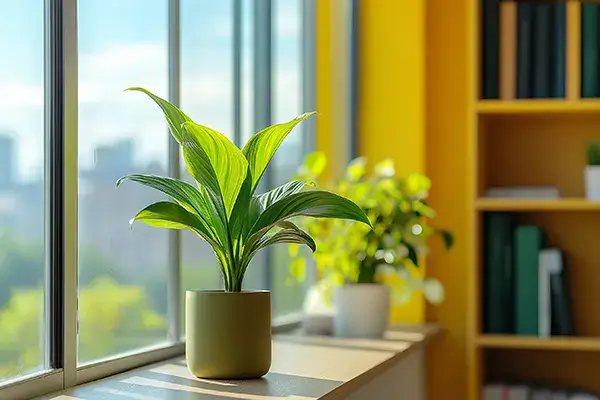Transforming your office desk into a serene oasis is easier than you might think. Bonsai plants, with their miniature charm and artistic appeal, offer the perfect solution for bringing nature indoors. These tiny trees not only add a touch of elegance to your workspace but also provide numerous benefits for your well-being.
Whether you're a seasoned plant enthusiast or a beginner looking to add some greenery to your office, bonsai plants are an excellent choice. They're compact, low-maintenance, and can thrive in indoor environments. In this article, we'll explore the best bonsai plants for your office desk, along with tips on how to care for them and maximise their impact on your workspace.
What Are Bonsai Plants?
Bonsai plants are miniature trees grown in containers, originating from China and Japan. The term "bonsai" translates to "tree in a pot". These tiny trees range from a few inches to a few feet tall, cultivated through careful pruning and wiring techniques. Bonsai plants are characterised by their small size and artistically shaped forms, making them ideal for office desks. Popular varieties for indoor environments include Chinese Elm and Ficus, known for their adaptability and air-purifying qualities.
Benefits of Bonsai Plants for Office Desks
Bonsai plants offer numerous advantages when placed on office desks. These miniature trees not only enhance the workspace but also contribute to employee well-being and productivity.
Aesthetic Appeal
Bonsai plants transform office desks into visually stunning spaces. They're miniature works of art that add sophistication and elegance to your workspace. With their unique shapes and compact size, bonsai trees create an eye-catching focal point, impressing clients and colleagues alike.
Stress Reduction
Caring for bonsai plants is a meditative practice that reduces stress levels. The act of nurturing these miniature trees helps lower anxiety, decrease tension, and promote tranquillity. Studies show that having plants in the office, including bonsai, improves focus and overall well-being, making your workday more manageable.
Air Purification
Bonsai plants, like other indoor greenery, play a crucial role in improving air quality. They act as natural air purifiers, removing harmful toxins and pollutants from your office environment. By absorbing carbon dioxide and releasing oxygen, bonsai trees contribute to a healthier, more breathable workspace.
Best Bonsai Plants for Office Desks
Selecting the right bonsai for your office desk enhances your workspace's aesthetics and improves air quality. Here are three top choices for office bonsai plants:
Ficus Bonsai
Ficus bonsai, particularly Ficus Benjamina and Ficus Retusa, thrive in office environments. These resilient trees adapt to various light conditions, including low light, making them ideal for offices with limited natural sunlight. With glossy green leaves and air-purifying qualities, Ficus bonsai improve office air quality and employee well-being. They're easy to care for, needing regular watering and occasional pruning.
Jade Bonsai
Dwarf Jade bonsai is a compact and charming option for office desks. Its small, round leaves and thick trunk-like stems suit smaller office spaces without overwhelming them. Jade bonsai are drought-tolerant and require minimal care, making them perfect for busy professionals. They thrive in bright, indirect light and add a touch of elegance to any workspace.
Chinese Elm Bonsai
Chinese Elm bonsai are versatile and hardy, adapting well to indoor office environments. Their small, delicate leaves and graceful branches create an attractive focal point on your desk. Chinese Elms tolerate low light conditions and irregular watering, making them ideal for office settings. These bonsai also contribute to air purification, enhancing your workspace's overall atmosphere.
Caring for Your Office Desk Bonsai
Proper care is essential for maintaining a healthy and thriving bonsai on your office desk. Here's what you need to know about caring for your miniature tree in an office environment:
Watering and Humidity
Water your bonsai regularly, but avoid overwatering to prevent yellowing leaves. Choose a larger pot to retain more water, especially if you're away on weekends. For humidity-loving species like Fukien Tea, use a humidifier or place the bonsai on a tray with pebbles and water to maintain optimal moisture levels.
Light Requirements
Position your bonsai near a window to receive adequate natural light. Most office bonsai thrive in bright, indirect sunlight. If natural light is limited, supplement with grow lights to ensure your bonsai receives 12-16 hours of light daily. Rotate the plant regularly for even growth.
Pruning and Shaping
Prune your bonsai regularly to maintain its shape and size. Use sharp, clean scissors to remove dead leaves, branches, and excessive growth. Shape your bonsai by wiring branches gently, but remove wires after 2-3 months to prevent scarring. Trim roots annually to keep the plant compact.
Where to Place Your Bonsai on Your Office Desk
Positioning your bonsai correctly is crucial for its health and your enjoyment. Place it near a window for indirect natural light, but avoid direct sunlight. If natural light's scarce, use a 2-foot fluorescent light 3 feet above the desk. Keep your bonsai away from heating or cooling vents to maintain stable temperatures. Choose a spot that's easily visible and accessible for regular care and appreciation.
Conclusion
Bonsai plants are an excellent choice for office desks, offering aesthetic appeal and well-being benefits. Chinese Elms, Ligustrums, and Dwarf Schefflera thrive in office conditions. Ensure proper lighting, either through natural light or a lamp, and choose larger containers for better water retention. With the right care and positioning, your bonsai will transform your workspace into a tranquil, visually stunning environment, improving air quality and reducing stress.
Key Takeaways
- Bonsai plants offer aesthetic appeal, stress reduction, and air purification benefits for office spaces
- Top choices for office desk bonsai include Ficus, Jade, and Chinese Elm varieties
- Proper care involves regular watering, adequate lighting, and occasional pruning for optimal growth
- Position your bonsai near a window for natural light or use grow lights if necessary
- Choose larger pots for better water retention, especially for weekend care
- With proper care, bonsai plants can transform your workspace into a tranquil and visually stunning environment

